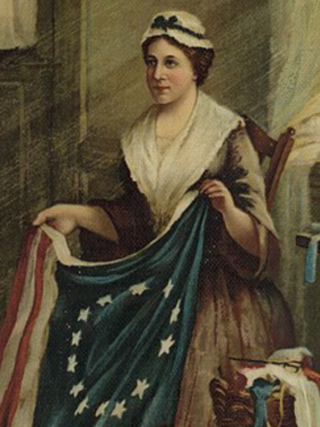Related Research Articles

Ann Street Barry aka Ann Dancer later Ann Crawford, was a British singer, dancer and stage actress.

Elizabeth Griscom Ross, also known by her second and third married names, Ashburn and Claypoole, was an American upholsterer who was credited by her relatives in 1870 with making the second official U.S. flag, accordingly known as the Betsy Ross flag. Though most historians dismiss the story, Ross family tradition holds that General George Washington, commander-in-chief of the Continental Army and two members of a congressional committee—Robert Morris and George Ross—visited Mrs. Ross in 1776. Mrs. Ross convinced George Washington to change the shape of the stars in a sketch of a flag he showed her from six-pointed to five-pointed by demonstrating that it was easier and speedier to cut the latter. However, there is no archival evidence or other recorded verbal tradition to substantiate this story of the first U.S. flag. It appears that the story first surfaced in the writings of her grandson in the 1870s, with no mention or documentation in earlier decades.

The Schuyler family was a prominent Dutch family in New York and New Jersey in the 18th and 19th centuries, whose descendants played a critical role in the formation of the United States, in leading government and business in North America and served as leaders in business, military, politics, and society. The other two most influential New York dynasties of the 18th and 19th centuries were the Livingston family and the Clinton family.

TheNewport Mercury, was an early American colonial newspaper founded in 1758 by Ann Smith Franklin (1696–1763), and her son, James Franklin (1730–1762), the nephew of Benjamin Franklin. The newspaper was printed on a printing press imported by Franklin's father, James Franklin (1697–1735), in 1717 from London. The Mercury may be the first newspaper published by a woman in the colonial United States. The Mercury was the also first paper to publish poetry by an African American woman, Phillis Wheatley.
Francis Newbery was an English publisher and businessman.
Alexander Kincaid (1710–1777) was an 18th-century Scottish printer and publisher who served as Lord Provost of Edinburgh 1776/77.
Dick's Coffee House was a significant Irish coffeehouse in the 17th and 18th century.
Richard Pue was an Irish newspaper publisher, bookseller, and proprietor of Dick's Coffee House.
Sarah Hyde was an Irish printer and bookseller.
Elizabeth Pue was an Irish newspaper publisher, bookseller, and proprietor of Dick's Coffee House.
Sarah Harding was an Irish printer and publisher who suffered "inopportune imprisonments" for some of her publications. She is known for publishing Jonathan Swift's A modest proposal in 1729.
Elizabeth Watts Lynch, known as Mrs Lynch, was an Irish printer, stationer, and "bookseller to the courts of law".
Alice Reilly was an Irish printer and publisher.
Daniel Graisberry was an Irish printer.
Catherine Finn was an Irish printer and owner of Finn's Leinster Journal.
Sarah Cotter was an Irish printer and bookseller in the mid-18th century.
Mary Crooke was an Irish printer and bookseller.
Anne Esdall was an Irish printer, publisher, and bookseller.
Christchurch Place is a street in central Dublin, Ireland, formerly known as Skinners Row or Skinner's Row, it formed one of the main thoroughfares in medieval Dublin.
References
- 1 2 3 O'Riordan, Turlough (2009). "Sarah Pue in Pue, Richard". In McGuire, James; Quinn, James (eds.). Dictionary of Irish Biography . Cambridge: Cambridge University Press.
- 1 2 Pollard, Mary (2000). A dictionary of members of the Dublin book trade, 1550-1800 : based on the records of the Guild of St. Luke the Evangelist, Dublin. London: Bibliographical Society. p. 474. ISBN 9780948170119.
- ↑ Gilbert, Sir John Thomas. "A history of the city of Dublin, Volume 1". www.ebooksread.com. Retrieved 15 May 2020.